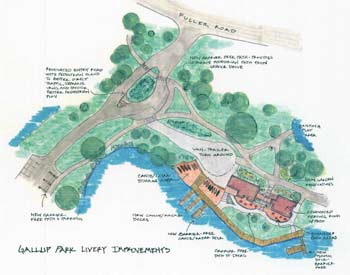Road construction makes pedestrian crossing challenging, despite the signage. [photo]
Stories indexed with the term ‘accessibility’
AAATA Gears Up for More Accessible Service
Ann Arbor Area Transportation Authority board meeting (July 24, 2014): The board’s meeting this month was the next-to-last one before the initial expansion of services that the transit authority will be implementing. The expansion results from the new millage that was approved in a voter referendum held on May 6, 2014. The rollout of additional service is scheduled for Aug. 24, while the board’s next meeting is three days before that.
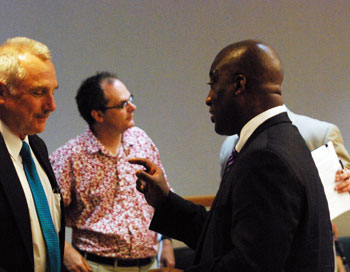
From left: AAATA strategic planner Michael Benham, Ed Vielmetti (background) and CEO Michael Ford, talked after the meeting.
The board barely achieved a quorum – with six of 10 board members attending. Anya Dale presided over the meeting in the absence of board chair Charles Griffith.
The board received some updates on the preparations for implementing that expanded service plan. And three of the board’s July 24 voting items were related at least indirectly to the additional services: a plan for acquiring 20 new buses; adjustments to the current fiscal year’s operating budget; and a tweak to the AAATA’s mission statement.
The mission statement was modified to highlight “accessible” as the kind of transit services that the AAATA aspires to provide. The change to the mission statement also reflected the addition last year of the word “area” to the name of the organization. That name change came as the result of adding the city of Ypsilanti as well as Ypsilanti Township as members of the authority. Previously, the city of Ann Arbor had been the sole member. The additional services will be paid for with a millage levied on property owners from all the member jurisdictions.
The fiscal 2014 budget ends Sept. 30. Revenues were adjusted to reflect the millage revenue. Of the additional $4,543,695 in local millage revenues, $3,850,000 is being put toward next year’s FY 2015 budget. Adjustments to this year’s budget include changes to reflect the hiring and training of 11 new bus drivers, bringing the total to 138 drivers. An operations supervisor, two new vehicle mechanics, an additional service crew member, and a human resources administrative assistant will also be added.
The additional 20 buses the AAATA is acquiring for the service expansion are spread over the next three years, with two to be acquired this year, 11 in FY 2015 and 7 in FY 2016. The buses for FY 2015 and 2016 will be paid for with the additional local millage funds, while the buses this year will tap a federal grant with matching state funds. A public hearing was held on the federal grant application that will include those two buses.
Potential future expansion of services – in addition to those to be implemented starting Aug. 24 – was also reflected in a voting item on the board’s July 24 agenda. The board approved an increase in the contract with SmithGroupJJR from $105,200 to $800,000 – to continue study of north-south commuter rail options between Howell and Ann Arbor. An earlier phase of the study for the WALLY (Washtenaw and Livingston Railway) project identified a segment of the Ann Arbor Railroad right-of-way, between Liberty and Washington streets, as a preferred location for a downtown Ann Arbor station. A portion of the work is being paid for with a $640,000 federal Transportation, Community and System Preservation (TCSP) program grant.
The final voting item on the board’s agenda was a $234,360 contract with GZA GeoEnvironmental to perform environmental cleanup work at the AAATA headquarters building at 2700 S. Industrial Highway. The cleanup, which involves contamination from a gasoline leak that was identified in 2010, is covered by insurance.
At its July 24 meeting, the board also heard its usual range of updates, reports and public commentary, much of which highlighted the idea of accessibility. [Full Story]
Column: City Council as Entertainment
About the author: Dave Askins is editor and co-founder of The Ann Arbor Chronicle. He’s covered every Ann Arbor city council meeting since September 2008.

This is a mock-up of how the city of Ann Arbor might provide a text box with councilmember amended text in real time, just underneath the online CTN video stream of council meetings. (Art by The Chronicle.)
If you’ve never watched an Ann Arbor city council meeting in person or on Community Television Network, you really should give it a try sometime. The next chance to watch your local elected officials in action is April 7, 2014 with a scheduled start of 7 p.m.
As an entertainment option, I’d allow that a city council meeting probably falls somewhat short of the Netflix series “House of Cards” or the ABC series “Scandal.” That’s actually OK with me – because journalists in those dramas have been shoved in front of trains and shot dead on the street.
But any long-running TV series is more entertaining to watch if you understand exactly what is going on. If you have elderly eyes, for example, you might not be able to see if that text message Frank Underwood received was from Zoe Barnes or Olivia Pope. It makes an episode hard to follow, if you don’t know who sent Underwood that text message.
One of the hardest parts of a city council meeting to follow – even if you are well-versed in the subject matter – is any deliberation featuring wordsmithing of amendments to text.
So in the interest of making Ann Arbor city council meetings more entertaining, I’d like to propose a simple step toward helping the viewing public understand exactly what’s going on: Let the public see amended text in real time.
How could councilmembers, in real time, make visible to the public proposed amendments to text already under consideration?
An easy technical solution already exists.
It’s free, and it requires no registration or creation of user accounts. And it’s not Google Drive. [Full Story]
AirRide OK’d, State Funding Reviewed
Ann Arbor Area Transportation Authority board meeting (March 20, 2014): Board chair Charles Griffith opened the meeting by noting that the agenda was a lot lighter than last month, when the board had passed 10 separate resolutions – including a vote to put a transit millage proposal on the May 6 ballot.

Looking north on Fifth Avenue at the AirRide stop, just south of the newly opened Blake Transit Center. (Photos by the writer.)
The only voting item handled by the board at its March 20 meeting was the extension of a contract with Michigan Flyer to provide service between downtown Ann Arbor and Detroit Metro Airport. The board authorized the first of three one-year extensions on the initial two-year contract for the service, called AirRide.
For the third year of the agreement, the not-to-exceed amount is $170,000. That compares with the first year of the contract that was not to exceed $700,000. The drop in the cost to the AAATA stems from a revenue-sharing agreement based on fare revenues – and ridership has exceeded projections.
The board also received an update on statewide transit issues from Clark Harder, executive director of the Michigan Public Transit Association, and Dusty Fancher, a lobbyist with Midwest Strategy Group. A main theme from their presentation was the need to focus on overall funding increases, as opposed to trying to fine-tune the part of the funding formula that divides public transportation funding among the 78 transit agencies in Michigan.
Harder also described an initiative to provide a non-emergency medical transportation brokerage that would tap public transportation resources. A demonstration program, to be provided through the newly formed Michigan Transportation Connection (MTC), could be up and running by Oct. 1, 2015, Harder reported.
Another highlight of that presentation included the idea that the abysmal road conditions – which have resulted from the long and harsh winter – could be a rallying point for more transportation funding. To the extent that additional money for transportation is funneled through the general transportation funding formula, that would lead to an increase in public transportation funding, along with funding for road infrastructure.
The harsh winter and the challenge of clearing snow at the 1,200 bus stops was also a part of another basic theme of the board’s discussion – accessibility of the bus service to those in the disability community. Carolyn Grawi of the Ann Arbor Center for Independent Living addressed the board to stress the importance of making sure all the bus stops are accessible. She also reiterated the CIL’s support for the upcoming May 6 millage vote.
Other highlights from the meeting included a round of applause for AAATA maintenance manager Terry Black, who managed the Blake Transit Center construction project. The driveways still need concrete to be poured before the project is completed, but the building itself is now open to the public. [Full Story]
Rotary to Fund Universal Access Playground
Ann Arbor park advisory commission meeting (Jan. 28, 2014): Park commissioners got news at their most recent meeting that the Rotary Club of Ann Arbor is making a $250,000 contribution to the city of Ann Arbor for a major new “universal access” playground at Gallup Park, to celebrate the club’s centennial anniversary in 2016.
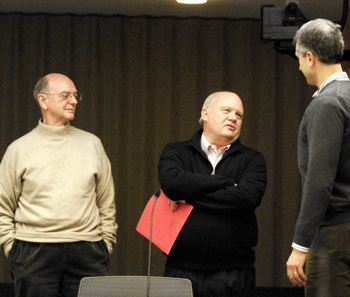
From left: Bernie Lugauer and Bob Buckler of the Rotary Club of Ann Arbor talk with Christopher Taylor, an ex officio member of the Ann Arbor park advisory commission. (Photos by the writer.)
After a presentation on Jan. 28, commissioners recommended that the city apply for a state Dept. of Natural Resources grant to help fund the remainder of the work, which is estimated to cost $500,000.
Colin Smith, the city’s parks and recreation manager, told commissioners that although there are about 80 playgrounds in Ann Arbor, none are universally accessible. It’s a “huge shortcoming” for the parks system, he said. The exact location within Gallup Park hasn’t been determined, but the playground would be about 5,000 square feet and exceed the requirements of the Americans with Disabilities Act (ADA). The design and equipment is intended to create environments that can be used by all people, with features like ramps, color-contrasting structures, wider bridges and walkways, and playground equipment that makes it easier for people using wheelchairs.
Two Rotary representatives attended the Jan. 28 meeting to help describe the club’s role in the project. Bob Buckler, a Rotary director and co-chair of the group’s centennial committee, told commissioners that in general the Rotary’s primary focus is on supporting children, by funding scholarships, Washtenaw Success By Six and other programs. That’s why the universal access playground is so appealing as a way to celebrate Rotary’s centennial, he said. Buckler indicated that fundraising for this project has already begun. The grand opening is expected to be on Labor Day in 2016.
In other action on Jan. 28, commissioners approved the location for new tennis courts at Windemere Park – a project that’s been in the works for about two years. The location has been somewhat controversial among neighbors, and prompted a review of the previously selected site. The current courts have deteriorated and are in a location where it’s unsuitable to rebuild.
Also on Jan. 28, PAC recommended the purchase of two vans to keep up with the increasing shuttle transportation demands for Huron River trips in 2013, following the opening of Argo Cascades.
The meeting marked a transition of members on PAC. It was the first meeting for David Santacroce, who was appointed by the city council last year to replace Julie Grand. And it was the final meeting for Jen Geer, who has resigned after less than a year on the commission. Paige Morrison was appointed by the council on Feb. 3 to fill the remainder of Geer’s term – through May 19, 2016. [Full Story]
Rotary Pledges $250K for Gallup Park Playground
The Rotary Club of Ann Arbor is making a $250,000 contribution to the city of Ann Arbor for a major new “universal access” playground at Gallup Park, to celebrate the club’s centennial anniversary in 2016. A presentation about the project was made at the Jan. 28, 2014 meeting of the Ann Arbor park advisory committee meeting.
Colin Smith, the city’s parks & recreation manager, described a universal access playground as one that exceeds the requirements of the Americans with Disabilities Act (ADA). It aims to create environments that can be used by all people. There are about 80 playgrounds in Ann Arbor, but none are universally accessible, he said, calling it a “huge shortcoming” for the parks system. In part … [Full Story]
Monthly Milestone: Watching Words
The Chronicle’s November milestone column comes to you a few days earlier than the customary second day of the month. That’s because I wanted to include a quick preview of a performance scheduled for Nov. 1 at the Kerrytown Concert House – by mezzo soprano Laurie Rubin.
The Chronicle has rarely, if ever, written about entertainment. And as I explained to Laurie, when she called me up to make her pitch, our approach to covering Ann Arbor’s community doesn’t include standard “preview” pieces for live performances.
The boilerplate explanation I typically use on the phone includes a description of The Chronicle’s preferred strategy for giving readers advance notice of interesting performances. That strategy is an event listing that runs off Internet standards-compliant data feeds and helps to strengthen the community’s “calendar web.” So obviously the tactic here is partly designed to bore the caller to death, so that they’ll just give up and accept the fact that I’m not going to write a preview article about their performance.
You will find Laurie’s Nov. 1 Kerrytown Concert House performance included in The Chronicle’s event calendar, categorized as music.
Fortunately for you, dear readers, Laurie declined my gambit that she surrender to my boring, rambling talk about data feeds and technology platforms. Instead she expressed a weirdly geeked-out interest in these data feeds and calendars, which I probably seemed very excited about. She instantly grasped the concept of maintaining a calendar that automatically generates a data feed that any publication or individual can access. I didn’t figure that an opera singer would be such a receptive audience for that sort of thing. But at least she had stopped talking about her Nov. 1 performance at Kerrytown Concert House, so that was a good thing, from my point of view.
But in closing out the conversation, Laurie renewed her pitch for a preview article, based on her memoir, “Do You Dream in Color: Insights from a Girl Without Sight.” Even though I was still thinking to myself, “No preview articles! Not even for blind opera singers!” I figured Laurie might be a receptive audience for some additional conversation about a different topic.
That topic is an accessibility project for public meetings that The Chronicle has been working on somewhat sporadically. The idea is to provide digital streaming text for members of the deaf and hearing-impaired community to read – either live at public meetings or during a video replay. Yes, I fully understood that I was talking to a self-described “blind girl” – for whom this particular accessibility project offered zero obvious benefit. Yet Laurie turned out to be a willing conversation partner. And in The Chronicle’s basic technological approach, she saw a potential benefit to the blind and visually impaired community that would never have occurred to me. [Full Story]
Gallup Park Accessibility Work OK’d
A $512,180 contract to Construction Solutions Inc. for improvements at the Gallup Park canoe livery has been approved by the Ann Arbor city council. The council’s vote came at its April 1, 2013 meeting.
The Ann Arbor park advisory commission had recommended the contract award at its March 19, 2013 meeting. The project budget includes a 10% construction contingency, bringing the total cost to $563,398.
Construction Solutions, based in Ann Arbor, was the lowest qualified bidder on the project. … [Full Story]
Park Issues Dominate Council Deliberations
Ann Arbor city council meeting (July 16, 2012): The bulk of the council’s recent meeting was related to parks – either directly or tangentially.
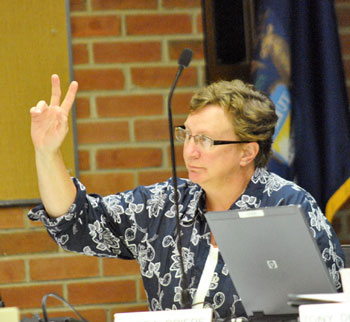
Councilmember Sandi Smith (Ward 1) asks to be called on during the July 16 meeting. (Photos by the writer.)
The council considered a resolution that would have placed a question on the Nov. 6 ballot about a charter amendment affecting city parkland. The amendment would require a voter referendum not just for the sale of parkland, but also for leases or other contracts that have a practical effect similar to a sale.
The majority of the council wanted to allow time for the city’s park advisory commission (PAC) to weigh in before taking council action. To facilitate that timeline, PAC is convening a special meeting on Aug. 8 to consider the matter. The council’s postponement was until Aug. 9 – its next regularly scheduled meeting. That’s a Thursday instead of the usual Monday, pushed back because of the Aug. 7 primary election.
Some supporters of the possible amendment had hoped to bring the matter to a council vote before the August primary, because they wanted incumbent council candidates to be judged by the electorate based on their vote on the parkland ballot question. That led Sandi Smith (Ward 1), who is not seeking re-election to a third term, to call the resolution on the ballot question a “poorly disguised political stunt.”
Other park-related items on the agenda included approval of a $89,560 contract with Wally Hollyday Skateparks for the design and construction oversight of a skatepark to be built in the northeast corner of Veterans Memorial Park. The council also gave initial approval to the rezoning of two parcels recently acquired by the city for expansion of the Bluffs Nature Area at 1099 N. Main St., north of Sunset Road. On final approval, both parcels will receive the PL (public land) zoning designation. The city expects the additional land to make the entrance to the nature area more accessible.
The Leslie Science and Nature Center will get $115,309 worth of improvements to create accessible pathways at the city-owned site – the council approved a contract with JB Contractors Inc. for that work. The center is operated by a separate independent nonprofit on land and buildings that are owned and maintained by the city of Ann Arbor.
The possibility of a mixed-use park and art center at the city-owned 415 W. Washington property was given a chance to move forward, with the council’s authorization of $50,000 in general fund money to pay for physical surveys of the building on the property. The building, which would potentially house a space for working artists, would need environmental, hazardous materials and topographic surveys done, even if a decision were ultimately made to demolish the building.
Open space outside the city got a boost from the council’s acceptance of $396,900 in federal funds for the purchase of development rights (PDR) on properties in Webster and Superior townships. The federal funds will be matched with city funds from the open space and parkland preservation millage, which supports the city’s greenbelt program.
The wetlands at Plymouth Parkway Park that were impacted by last year’s railroad embankment washout along Plymouth Road will be restored through a $97,687 contract with Fonson Inc. authorized by the council. The funds will come from the city’s park maintenance and capital improvements millage.
Only tangentially related to parks was the council’s approval of the site plan for the Maple Cove development. Located on 2.96 acres at 1649 N. Maple, north of Miller Road between North Maple and Calvin Street on the city’s west side, the plan calls for combining two sites – 1649 N. Maple and 1718 Calvin – and demolishing an existing single-family home and detached garages there. Two 3-story apartment buildings would be built with a 64-space parking lot. The project also includes building a private street to serve seven new single-family houses near Calvin Street.
The parks connection to Maple Cove is that the city requested a $26,660 contribution from the developer to support the city’s parks – a voluntary contribution, with the amount determined by formula. The developer has declined to make that contribution.
The council also voted to appoint John Seto as chief of police and head of safety services – he’s now permanently in charge of policing the city, including city parkland. Seto has served since April as interim in the wake of Barnett Jones’ retirement.
In other action, councilmembers voted to suspend the use of construction unity board (CUB) agreements in construction contracts – after voting to restore their use earlier this summer. On the CUB issue, the council has been responding to a changing landscape of law, as state legislation is passed and court decisions are handed down. [Full Story]
Ann Arbor Public Meetings Now Live on Web
At the city council’s March 21, 2011 meeting, city administrator Roger Fraser mentioned that the city council’s meetings would now be available streamed live over the web: [CTN Channel 16 Live]. Previously, the city has provided access to archived coverage of public meetings through its video-on-demand service: [Ann Arbor Public Meetings Archive]
AATA Adopts “Smart Growth” as Plan Basis
At its March 17, 2011 meeting, the Ann Arbor Transportation Authority board voted unanimously to adopt a “Smart Growth” scenario as the basis of continued development of its transportation master plan (TMP). The Smart Growth scenario is the most ambitious of three scenarios the AATA has developed, which unfolded over the course of a planning and public engagement process that began in the summer of 2010.
Transit options in the three scenarios – which the AATA has labeled Lifeline Plus, Accessible County, and Smart Growth – are nested subsets, starting with Lifeline Plus as a base, which expands on existing services and focuses on services for seniors and disabled people. Accessible County extends services by adding fixed-route bus service to connect all the county’s urban centers. The Smart Growth scenario includes north-south and east-west commuter rail regional components, as well as high-capacity local transit options for corridors like Washtenaw Avenue and State-Plymouth.
Development of the TMP for countywide service has been identified by the AATA board as a necessary step to take before reorganizing the AATA as a transit authority for the entire county. In December 2009, the board held a special meeting to seek advice on various options for reorganization under Act 196 or Act 55. [Chronicle coverage "AATA Gets Advice on Countywide Transit"]
This brief was filed from the Ann Arbor District Library boardroom, where the AATA board holds its regular monthly meetings. A more detailed report will follow: [link] [Full Story]
AATA Board Fails to Achieve Quorum
Ann Arbor Transportation Authority board meeting (Aug. 19, 2010): On the occasion of its first meeting scheduled at the downtown location of the Ann Arbor District Library – which is to become its usual meeting place – the AATA board failed to achieve a quorum.
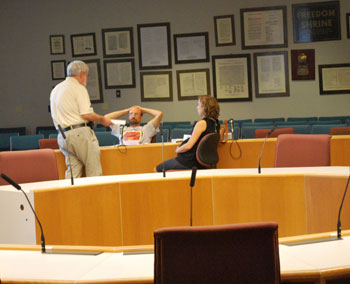
Left to right: AATA board members Jesse Bernstein, Roger Kerson and Anya Dale. The group fell one short of the four needed to constitute a quorum. (Photos by the writer.)
A quorum – the minimum number of board members needed in order to conduct business – consists of four members for the seven-member AATA board.
In attendance were Roger Kerson, Anya Dale – who were both recently appointed to the board – plus board chair Jesse Bernstein. The usually cheerful Bernstein seemed a bit glum, when he announced that no quorum would be achieved.
Bernstein told the handful of people assembled in the room – members of the public and the AATA staff – that he was “sorry and disappointed” and offered his apologies. He noted that it was the first occasion of a meeting scheduled at the library, and that the CTN staff were on hand to ensure the proceedings were videotaped. “See you next month!” he concluded. [Full Story]
Art Fairs: Accessible from a Teeter Totter
[Editor's Note: HD, a.k.a. Dave Askins, editor of The Ann Arbor Chronicle, is also publisher of an online series of interviews on a teeter totter. Introductions to new Teeter Talks appear on The Chronicle.]
Nine months have now passed between views of the world from the end of a teeter totter. This most recent view down the board was of Brian Kerr. One way I know Brian is as a downtown pedestrian who strolls hatless down the sidewalk, even in bitterly cold weather, and who must be admonished as you bicycle past: “Put on a hat, it’s cold out here!”
The chosen venue of our teeter totter ride was the middle of the intersection of Main and Liberty streets last Saturday morning, the last day of the Ann Arbor art fairs. We compromised on our chosen venue somewhat by moving to the edge of the intersection, to accommodate concerns of art fair staff.
It was a small concession to make – we’d already dealt with the disappointment of being denied access to the bottom of the pit being dug for the underground parking garage along Fifth Avenue, just to the northeast. Construction sites can’t reasonably be expected to be made accessible to random members of the general public – patrons of the arts, teeter totter riders, wheelchair users, the blind. That makes construction sites somewhat different from websites.
Under the Section 508 amendment of the federal Rehabilitation Act of 1973, federal agencies are required to make their websites accessible to people with disabilities. It’s a different piece of legislation from the Americans with Disabilities Act, which just recently celebrated its 20th anniversary. But Section 508 is to websites what the ADA is to buildings – the idea is to make things accessible to disabled people.
Kerr works for a company called Deque, which specializes in helping to make websites work well for hearing- and visually-impaired people.
Here’s a simple example. Visually impaired people sometimes use a screen-reader to get information from a website – it’s a software program that tries to interpret the page using text-to-speech technology. If there’s a picture on a page, say of a guy sitting on teeter totter, then what the screen reader interprets – and what the visually-impaired person hears – is just an indication that there’s an image. If the author of the page supplies some description in the “behind the scenes” coding, the visually-impaired person might hear: “Brian Kerr, who is sitting on the end of a teeter totter. The view is down the board.”
Like librarian Metta Landsdale, Kerr has a professional interest in making information accessible to people. And like Lou Rosenfeld, Kerr is a product of the master’s degree program at the University of Michigan School of Information. And like Brandon Zwagerman, Kerr was one of a group of co-founders of ArborUpdate, a now-defunct local news and discussion website.
But there’s something else that Kerr has in common with Landsdale, Rosenfeld and Zwagerman. [Full Story]
UM Raises Tuition 1.5%, Budget Grows 6.75%
University of Michigan Board of Regents meeting (June 17, 2010): Budget presentations dominated the June meeting, the time of year when regents are asked to approve what have become inevitable tuition hikes for the university.
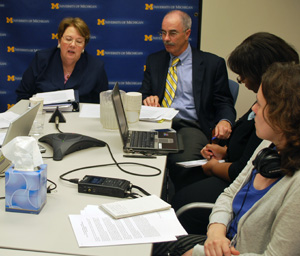
University of Michigan provost Teresa Sullivan, left, and vice provost Phil Hanlon brief the media about tuition rates immediately prior to the regents meeting on June 17. Hanlon will become provost when Sullivan leaves at the end of the month for her new post as University of Virginia president. (Photos by the writer.)
This year, with two regents dissenting, a tuition increase of 1.5% for in-state undergraduates was approved for the Ann Arbor campus. UM executives noted that it’s the lowest rate increase in 26 years – but if their projections for state appropriations prove too optimistic, they cautioned that they might need to return to request raising tuition later in the fiscal year.
University officials say they’re buffering the tuition increase by substantially adding to the amount of financial aid available to students – $126 million, up $8.3 million from the current year. They’re also launching a new “economic hardship” program, adding $500 in financial aid per year for up to four years for qualified students.
Tuition makes up a large portion of the general fund operating budget. For the Ann Arbor campus, a budget of $1.55 billion in FY 2011, which begins July 1, marks a 6.75% increase from FY 2010.
Regents also approved the FY2011 budget for the UM Hospitals and Health Centers – revenues are projected to top $2 billion for the first time during this year, with a $66 million operating surplus.
And UM athletic director Dave Brandon gave a briefing on the athletic department budget, though it doesn’t require regental approval. Projected revenues of $105 million includes $38.19 million from ticket sales, while the budgeted $100.3 million in expenses includes a $9.22 million debt service payment for Michigan Stadium renovations.
In addition to budgets, regents approved several construction projects, including a $56 million renovation of Alice Lloyd Hall and a $1.6 million repair of Burton Memorial Tower, which will close the landmark site – and silence its carillon – for about a year, starting in August. [Full Story]
AATA Adopts Vision: Countywide Service
Ann Arbor Transportation Authority board meeting (Nov. 18, 2009): At its Wednesday meeting, the AATA board took the first of the steps that CEO Michael Ford had recommended at their meeting on Oct. 29: adopt a vision statement and start developing a plan for a countywide system. The board will continue to address Ford’s recommendations by holding a special meeting on Dec. 8, at 5:30 p.m. at AATA headquarters to discuss formation of an Act 196 authority.
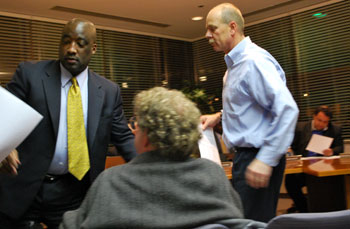
Michael Ford, left, had extra copies made of the treasurer's report and distributed them to audience members. (Photo by the writer.)
The board’s resolutions were complemented by a treasurer’s report from Ted Annis that laid out a possible budget within which the countywide system could be designed. Presentation of that report revealed some conceptual differences among board members in their preferred approach to engaging an outside consultant to do the countywide system design: (i) Here’s a budget, now design the system; or (ii) Design us a system, then tell us how much it would cost.
Key to the budget that Annis proposed was the assumed elimination of Ann Arbor’s transportation millage – on Annis’ assumption, Ann Arbor residents would pay the same countywide millage as other county residents if such a millage were approved.
In other business, the board approved service changes to Route #2 in northeast Ann Arbor.
Also generating discussion was the plan to repair, refurbish or reconstruct the Blake Transit Center in downtown Ann Arbor, which was described as “dilapidated.”
The board also received an explanation for the decreased ridership compared to last year, and a report on the move to different office space by the getDowntown program. [Full Story]
Pondering Ann Arbor Poll Accessibility
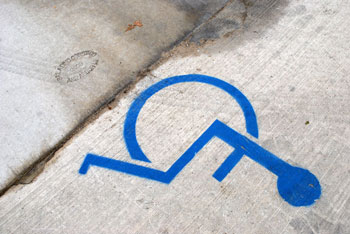
University Townhouses, the polling location for Precinct 5 in Ward 3, had specific improvements made under a 2005 grant. (Photo by the writer on Sept. 7, 2009; links to higher resolution file.)
In a letter dated Sept. 1, 2009, addressed to Ann Arbor’s city clerk, Jackie Beaudry, the nonprofit Michigan Protection & Advocacy Service Inc. gave the city a Sept. 15 deadline to respond to its concerns about accessibility to polling locations in Ann Arbor.
The response deadline comes two weeks ahead of the expiration of a grant for which the city was approved in 2007 under the Help America Vote Act (HAVA). The grant was for improvements in accessibility to Tappan and Eberwhite schools.
Lansing-based MPAS is concerned that the city has not submitted work for reimbursement under the 2007 grant. And that would put in jeopardy the city’s 2009 grant application for improvements to five additional locations – Northside, Dicken, Lawton, Lakewood and Pittsfield elementary schools. The MPAS letter paints a picture suggesting the city has not made progress towards addressing problems that the city itself identified in 2004 at 21 of the city’s 48 precincts.
However, after checking into the matter with MPAS, the state’s Bureau of Elections, and Ann Arbor city staff, The Chronicle has concluded that: (i) the situation with the 2007 grant is a matter of non-communication and paperwork follow-through, (ii) that prior to 2007, the city of Ann Arbor completed work under HAVA grants, with some reimbursements already made, and other payments still in process, and (iii) the city’s strategy for ensuring access uses a variety of temporary measures on election days, as well as a work plan for more permanent fixes. [Full Story]
DDA: No Character-District Zoning, Please
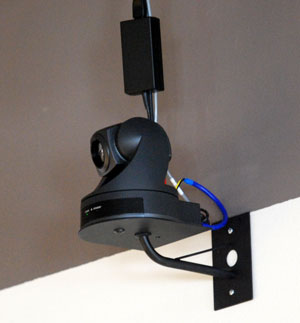
The board met at its usual location in the DDA offices, but this time it was recorded by three new wall-mounted video cameras. There's no schedule yet for the airing of the video material on CTN.
Downtown Development Authority board meeting (April 1, 2009): The board of the Ann Arbor Downtown Development Authority held its regular monthly meeting on Wednesday and passed a resolution – with some dissent – recommending that city council eliminate the character districts from the A2D2 zoning proposal.
The board also authorized spending around $75,000 to help start a business district in the Main Street area – an idea mentioned in our report on the board’s December 2008 meeting.
Additional spending, totaling around $25,000, was authorized for bicycle parking – some of it on-street.
The board also heard a report from its ad hoc committee on the discussion of the parking agreement with the city of Ann Arbor. Initial indications are that there was clear (but not unanimous) sentiment on the committee against renegotiating the existing agreement, but for exploring other alternatives.
Accessibility was a theme that came up in the form of DDA meeting material as well as real-time parking data. [Full Story]
AATA Board Gets City Council Feedback
AATA Board (Jan. 21, 2009): Board chair David Nacht began the meeting by saying, “It’s great to be here in a supportive environment,” possibly an allusion to his annual AATA update given the previous evening to Ann Arbor’s city council. Nacht then spent some time briefing his board colleagues on reaction from councilmembers and setting the wheels in motion to get them some answers to their questions.
Public commentary at the start and at the end of the meeting covered a range of topics, from snow removal at bus stops, to the status of RideTrak (it’s back on line a few days earlier than scheduled), to the proposed fare increases, to accessibility issues, to the AATA’s Capital and Categorical Grant Program. This last item was the subject of one of the two resolutions considered by the board (the board approved the 2009-13 plan), the other being its annually required notification of intent to apply for financial assistance from the state. [Meeting Packet 4MB .pdf] [Full Story]





